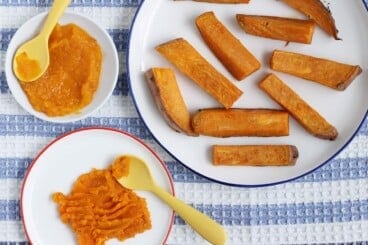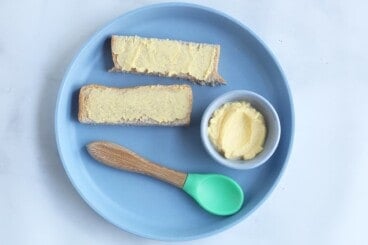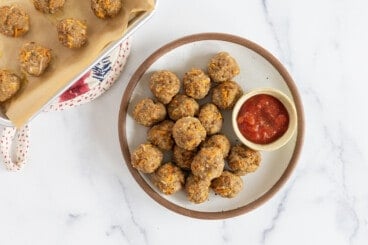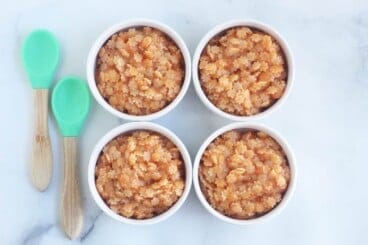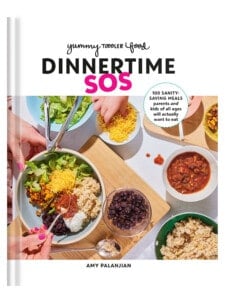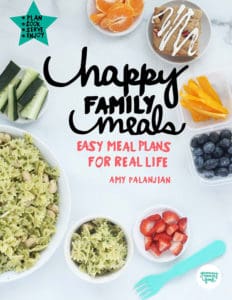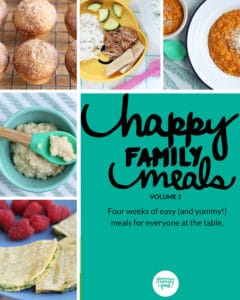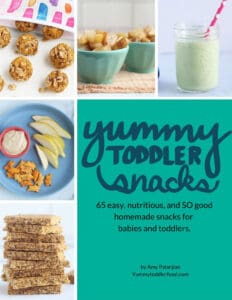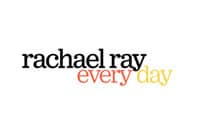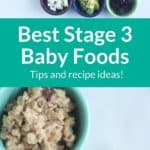Learn what stage 3 baby food includes, with the best recipes to try and tips to make meals and snacks easy for both you and baby!
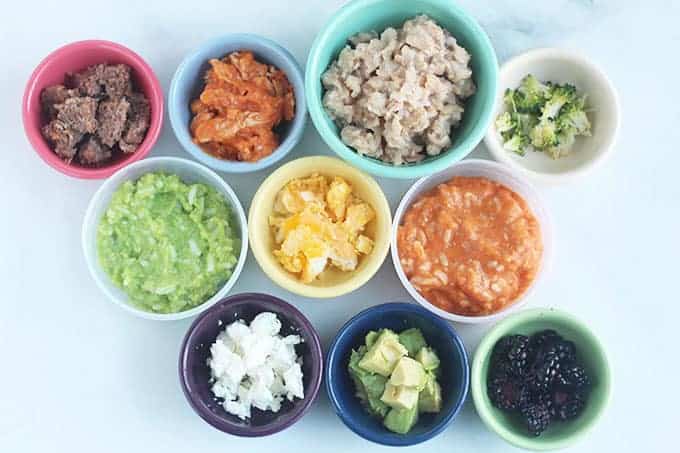
Stage 3 Baby Food
This stage of food for babies aged about 9 months and up includes thicker mashed foods and purees with a lot of texture. The foods are still very soft, but they are moving towards table foods and may include some finger foods. There will usually be bits of food for baby to chew and may include some foods that baby can pick up with her fingers.
These early finger foods include foods such as soft avocado, very soft scrambled eggs, mashed meatballs, grains including rice and rolled oats, slightly mashed raspberries.
TIP: Brush up on Baby Food Stages 101 here.
Your toddler won’t eat? Help is here!
Sign up for our email updates to get tips and ideas sent to your inbox.
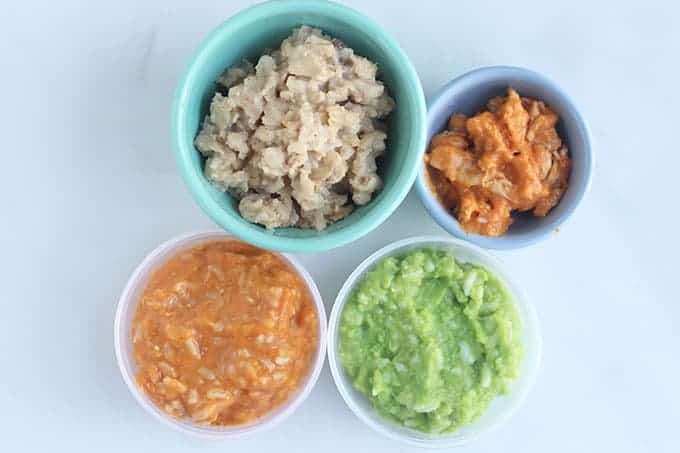
Easy Foods for 9-12 Months
For this age group, you can make baby food just for them—including thicker, more textured Baby Food Combinations—and also start to include more foods from your family meals if you haven’t been doing that already. The goal in this stage is to continue to expose baby to a range of flavors and textures so she continues to have lots of opportunities to learn and develop her ability to eat.
TIP: Check out my favorite easy method for serving nutrient-rich grains and pasta to this age group at the bottom of this post! My oldest was SO hungry at this age and this was my go-to way to make sure she was satisfied before bed.
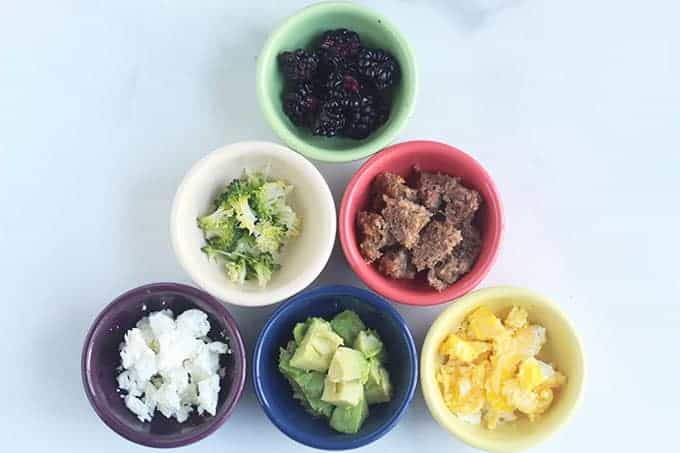
Frequently Asked Questions
Typically it’s for babies about 9 months and up, though there may be some normal variation in that age based on baby’s progression through learning to eat solids. Before this one, is Stage 2 which includes Baby Food Combinations.
Some examples include very soft risotto, soft oatmeal, pastina in a sauce or a tiny amount of broth, mashed meatballs, finely shredded and very soft beef or chicken, very soft scrambled eggs, and baby food purees that are thick and have soft chunks.
The main difference is that Stage 3 is thicker and has more texture than stage 2. It may also have more complex flavors (though Stage 2 should include a lot of flavors too!). Stage 3 may also include very soft finger foods.
Soft ones can be! You want them to be very easy to squish between two fingers to ensure that they are easy for baby to chew and move around in her mouth. Foods shown above including very soft minced broccoli (top parts only), diced or mashed meatball, crumbled goat cheese, diced avocado, small pieces of scrambled egg, and oatmeal can be great finger foods to start with. (Find more Early Finger Foods for Babies here.)
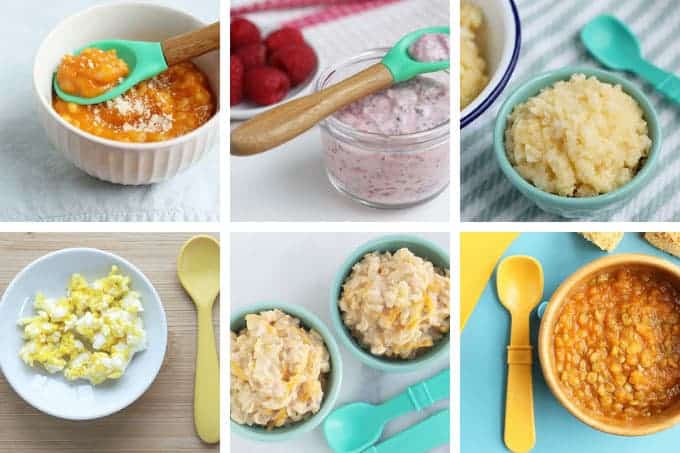
Stage 3 Recipes to Try
Here are some of my very favorite recipes for this age group. This is a nice place to start if you’re wanting to make food either just for baby, or to feed to the entire family. (Also: You can also mash other soft foods you have at the table. Anything you offer should be very easy to squeeze between your fingers.)
- 2-Ingredient Pancakes, diced up
- Alphabet Soup
- Apple Oatmeal
- Baked Oatmeal Cups
- Butternut Squash Risotto
- Carrot Cake Oatmeal
- Cauliflower Mac and Cheese
- Coconut Chia Pudding
- Healthy Meatballs, slightly mashed
- Instant Pot Butter Chicken
- Roasted Sweet Potato
- Spinach Pesto Pasta with Peas
- Slow Cooker Black Bean Soup
- Vegetarian Lentil Soup
TIP: Offer more flavors of baby food without the work with the awesome Intro to Veggies Pack from Amara Organic Baby Food. You get 30 meals (for less than $2 a day!) packed with a wide range of veggies including greens, squash, peas, sweet potatoes and more—no chopping, blending or steaming required! (sponsored)
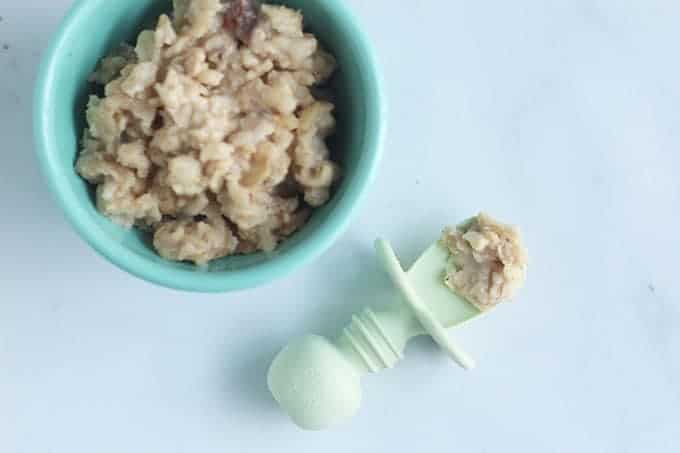
Best Tips for Stage 3 Foods
- Aim to include a range of textures and flavors so baby has a wide variety of food experiences.
- It is normal for some babies to like certain textures more than others, but do your best to continue offering all foods (they may just need more practice) and ensure that the food you offer is easy to eat.
- You can let baby feed themselves with their hands, offer preloaded spoons (see the image above), bites of food on a spoon, or a combination of the methods. With any of them, allow baby to decide when the meal is done, so end it when she turns her head, signs “all done” or gives another signal that the meal is over.
- Follow baby’s cue’s for hunger and fullness.
- Remember that there is a natural range among babies as far as how into food they are. Yours may be more or less into it, and that can be normal.
- Babies continue to rely on breastmilk and formula for their main nutritional needs until age 1, though solids gradually become more and more important—and are needed for nutrients including iron.
- At this stage, it is normal for a baby to be eating 1-2 meals. You can increase or decrease according to baby’s interest and hunger for solids, and also for your schedule. (Aim for 3 meals by the first birthday.)
Related Posts
Baby Food
Favorite Sweet Potato Baby Food
Baby Food
When can baby eat eggs?
Baby Food
Extra-Veggie Baby Pasta
I’d love to hear any comments or questions on this post, so please comment below to share!
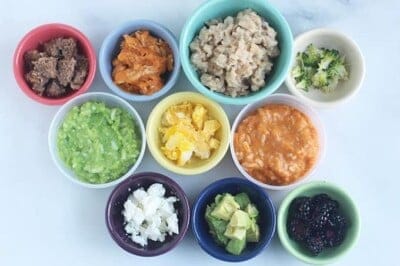
Best Stage 3 Baby Food
Ingredients
Grain or Meat (choose 1)
- 1/4 cup fully cooked brown rice, quinoa, bulgur, buckwheat, pastina, couscous, or any other grain you like (cook according to package directions); OR cooked ground beef, turkey, or chicken; OR mashed meatballs or shredded chicken or beef
Sauce or Puree (choose 1)
- 2 tablespoons-¼ cup Marinara Sauce, Sweet Potato Puree, Pea Puree, Pureed Red Lentil Soup, or any other baby food puree you like
Instructions
- Prepare your grain or meat, making sure they are cooked through and soft.
- Choose your sauce or puree.
- Add both to a medium bowl and stir together. Serve warm with a preloaded spoon or as a (somewhat messy) finger food.
- Store any leftovers in the fridge for up to 3 days or freeze for future weeks.
Video
Notes
- You can really use any soft grain or cooked meat you like using this method, it’s very versatile!
- Trust baby’s hunger and end the meal when they fuss, throw food, turn their head away, or give another signal that they are no longer hungry.
- 2-Ingredient Pancakes, diced up
- Alphabet Soup
- Apple Oatmeal
- Baked Oatmeal Cups
- Butternut Squash Risotto
- Carrot Cake Oatmeal
- Cauliflower Mac and Cheese
- Coconut Chia Pudding
- Healthy Meatballs, slightly mashed
- Instant Pot Butter Chicken
- Roasted Sweet Potato
- Spinach Pesto Pasta with Peas
- Slow Cooker Black Bean Soup
- Vegetarian Lentil Soup
